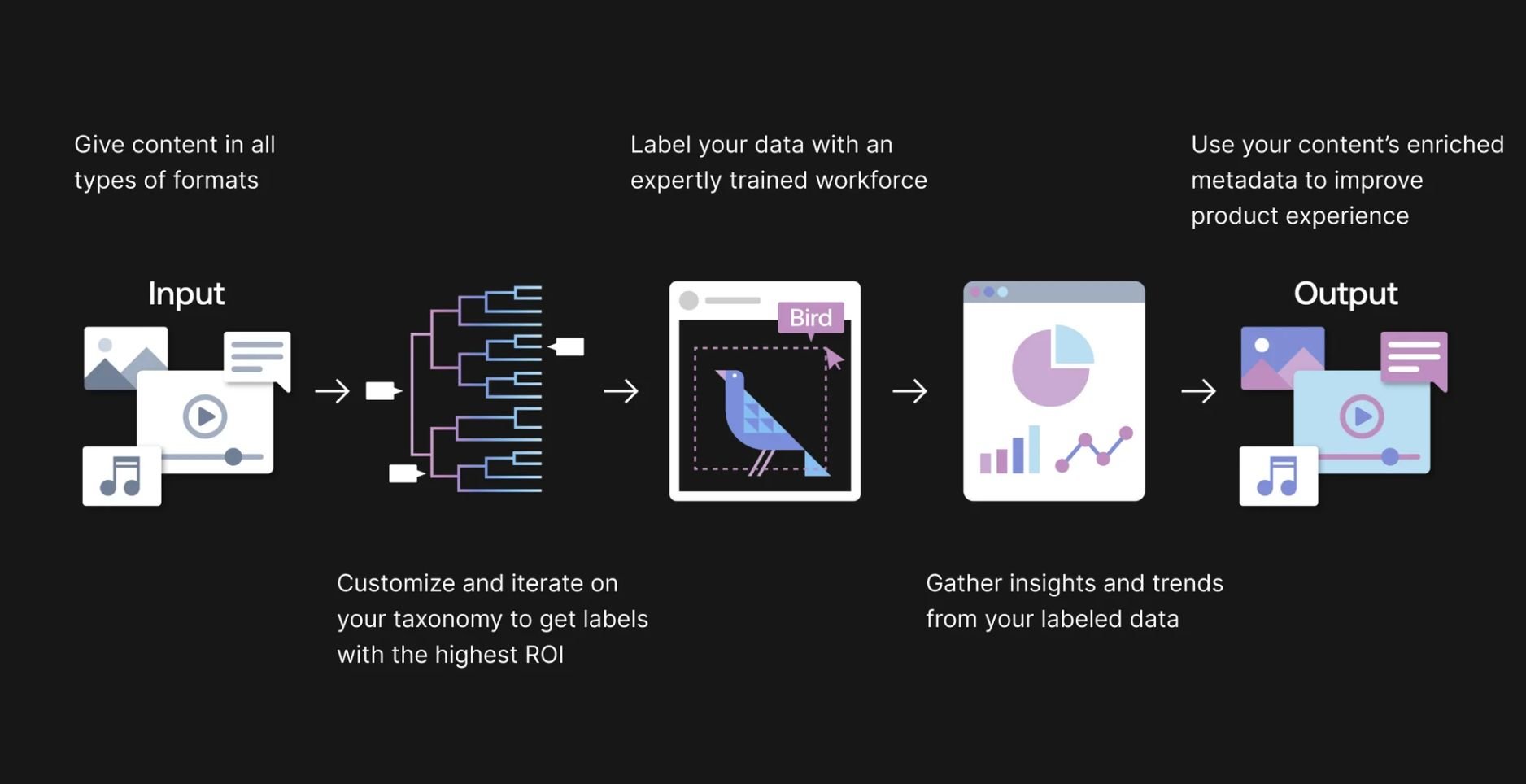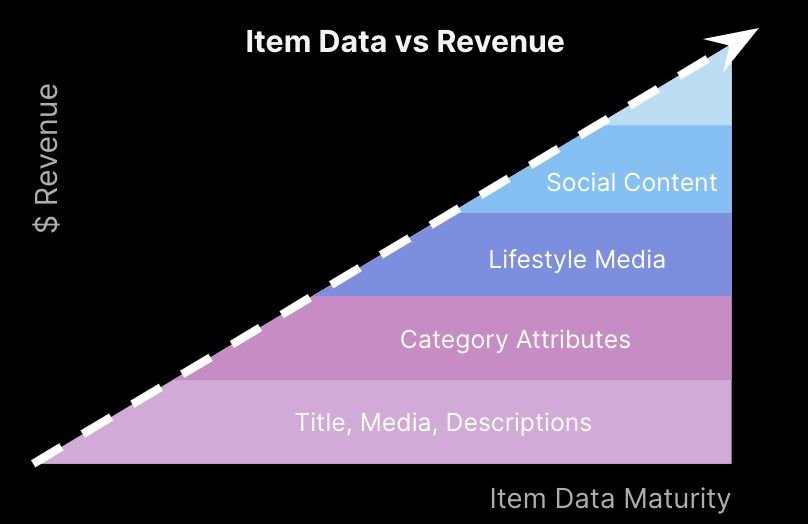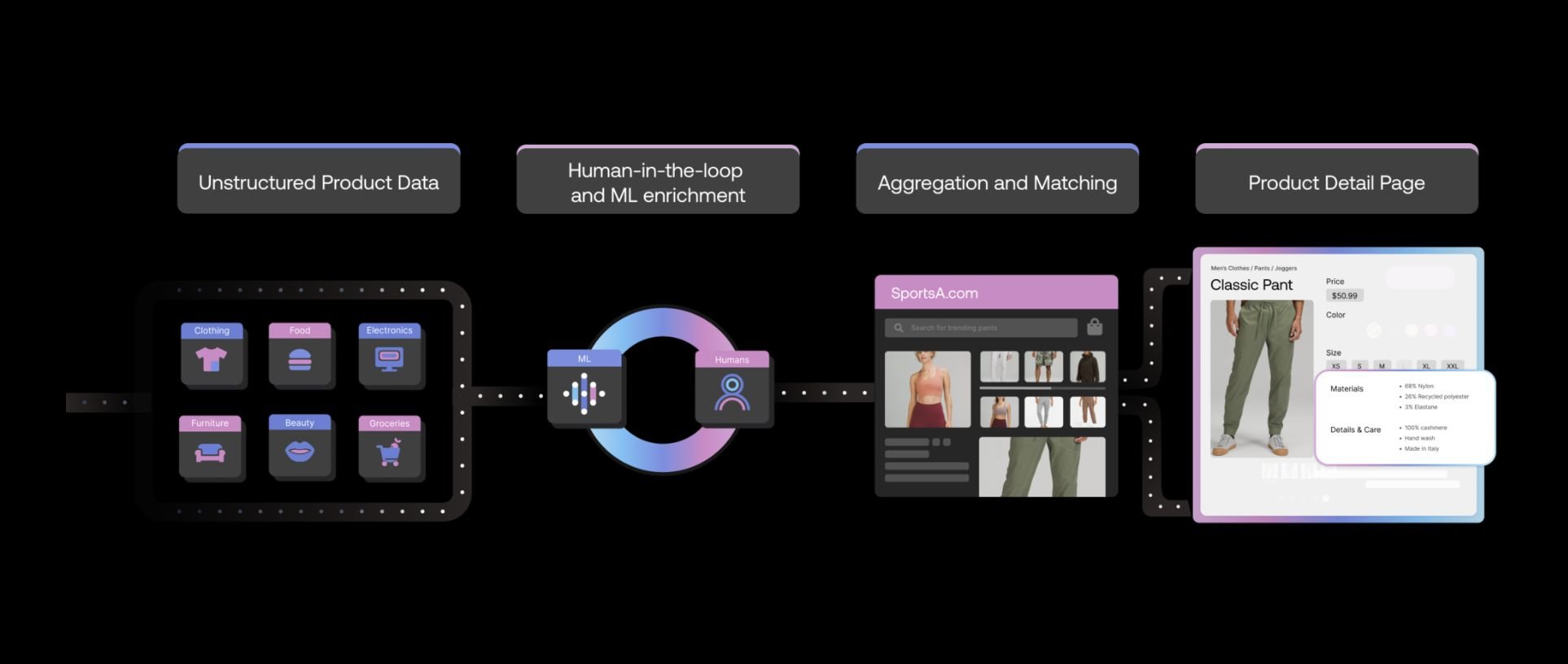Products
Solutions

Retail & eCommerce

Defense

Logistics

Autonomous Vehicles

Robotics

AR/VR

Content & Language

Smart Port Lab

Federal LLMs
Resources
Company
Customers
See all customersGuide to AI for eCommerce
This guide details the main applications of Artificial Intelligence for the eCommerce Industry.
By Scale Team on November 22nd, 2022
Contents
81% of retail executives say AI is at least moderately to fully functional in their organization. However, 78% of retail executives surveyed state it is hard to keep up with the evolving AI landscape. In recent years, eCommerce teams have accelerated the need to adapt to new customer preferences and create exceptional digital shopping experiences. AI adoption is no longer a choice but a necessity for retailers to drive growth at scale and maintain market differentiation. eCommerce companies are now using AI to create new forms of customer engagement, enhance online checkout solutions, and drive cost-effective processes for digital commerce.
This guide will provide a comprehensive overview of the main applications for AI in eCommerce companies and share best practices from Scale’s experience in retail.
There are several ways AI is beneficial for eCommerce:
Enhance the customer experience: AI solutions for eCommerce can help companies personalize product recommendations, improve search results, and better understand customer sentiment. With accurate personalization and recommendation machine learning models, companies can help reduce time to buy, accurately portray products on product detail pages, and better understand customer behavior. With an investment in accurate ML models, teams can achieve goals of increasing shopping conversion rates and higher customer satisfaction. In addition, eCommerce companies can increase trust and safety by removing content that violates platform guidelines, from user-generated content to merchant-specific data.
Maximize profitability: ML models can help deliver accurate and targeted product recommendations based on shopping and browsing history and segment customer profiling for more accurate advertising. Teams can better understand the content and product landscape By enriching content metadata with AI. This enables eCommerce companies to focus better on product and content growth efforts and narrow in on trends early.
Accelerate Operational Processes: Shopping and content trends move quickly where manual operational processes are too slow. Accelerate operational processes such as new merchant onboarding, demand forecasting, and content optimization. Techniques such as human-in-the-loop can augment machine learning models for human-level accuracy and quality.
Existing processes without AI do not scale to meet the changing needs of consumers. There are three key challenges that eCommerce marketplaces face:
- The cost and investment are exponential: Using in-house operations teams alone to manage eCommerce data and activate new products can often inhibit growth. Manual operations to source, clean, and enrich data are time-consuming. Generating new product assets, such as product descriptions and product photography, is costly.
- Lack of attribute data: Personalization systems are limited by sparse attribute data. Product data may include incorrect information, duplicates, and missing attributes leading to poor search and product recommendations. Insufficiently detailed content metadata on user behavior leads to content recommendation systems that fall short.
- Manual processes are too slow: Consumer behaviors and content trends move quickly. Current systems require too much time and process to discover and surface trending content, and platforms fall behind on retaining customer engagement and conversion.
In this guide, we’ll explain the main use cases to help solve these challenges and provide a roadmap to help grow your business with AI.
There are many different applications for AI in eCommerce. In this guide, we will focus on six main categories for data-centric applications in eCommerce:
- Search, Advertising, and Discovery
- Demand Forecasting and Inventory Management
- Chatbots and Customer Service
- Content Understanding
- Enriched Product Data
- AI-Generated Product Imagery
1. Search, Advertising, and Discovery
Strong customer experience starts with highly personalized recommendations, targeted product offers, and search relevance. There are three main use cases for personalized recommendations with AI:
Search relevance and item discovery: 49% of online purchasers scroll past the first page to look for what they want. Search and item discovery are key components to improving the customer shopping experience, and helping customers find the right product. AI-powered search engines use natural language processing (NLP) to process and understand the query. The search engine then uses the meaning to present best ranking search results. With AI-powered search relevance, eCommerce teams can better understand the true intention behind a search term and surface the most relevant results for a customer.
Ad and offer recommendations: Based on search, browse, add to cart, and purchase history, retailers can deliver targeted advertising and offers. Retailers can use machine learning to capture customer data, synthesize insights, and deliver a personalized shopping experience. Machine learning recommender systems use a recommender function, which takes information about the user including their browsing and purchase history, and predicts the rating the user will assign to a given product. Better enhanced data can aid in brands looking to deliver advertising and offers to customers. Targeted advertising aids in new customer acquisition and helps re-engage customers who may have abandoned their cart.
Product recommendations: For commerce teams who are looking to lift product sales, product recommendations are key to improving ROI. ML models analyze purchasing history and build lookalike customer audiences to deliver personalized product recommendations. For example, ML models can provide recommendations for similar products, products frequently purchased together, or products bought from lookalike audiences. Product recommendations add value to retailers by encouraging repeat purchases and increasing the average order value.
2. Demand Forecasting and Inventory Management
AI applications for supply chain management and logistics can dramatically accelerate processes in the global supply chain. There are three main use cases for supply chain management with AI:
Demand Forecasting: One of the greatest challenges in supply chain management is demand volatility. AI-powered demand forecasting uses machine learning algorithms to predict and recognize changes in consumer demand. ML algorithms use both historical time series data, such as pricing and promotions, and any associated data such as product features and categories to determine relationships in large datasets. This allows eCommerce teams to recognize demand patterns and forecast future demand fluctuations to reduce inventory loss.
Inventory management: Accurate AI-enabled demand forecasting has significant downstream impact on inventory management. Improved forecasting can lead up to 65% reduction in lost sales due to inventory that is out of stock. In addition to creating more accurate inventory, AI can help streamline aspects of warehouse management using Internet of Things (IoT) devices. With IoT, retailers can optimize warehouse operations and shipping processes with real-time inventory control.
Dynamic Pricing: With improved demand forecasting and inventory management, retailers can also set dynamic pricing to increase profit. Dynamic pricing enables teams to shift from traditional, manual static pricing to pricing that changes in real-time. AI algorithms use a combination of historical sales and price data, market demand, external events, and competitor pricing to generate a model based on the input parameters. Dynamic pricing has numerous benefits including better market segmentation, reduction of cost, and maximizing ROI.
3. Chatbots and Customer Service
Customer service is an increasingly important component to keep customers engaged and improve customer sentiment. However, keeping up with high-volume customer requests on multiple channels can be challenging. Similarly, live agents can be costly and increase response time. AI-powered chatbots are an integral part to helping solve these challenges for customer support. AI-driven chatbots are virtual assistants that use natural language processing and conversational AI to help respond to customer inquiries. There are four key ways Chatbots can support customer service:
- Engage and respond to customer inquiries: Chatbots can provide guidance for product related questions and answer frequently asked questions about sizing, product variants, or discounts.
- Boost sales processes: Chatbots can help provide product recommendations and reduce cart abandonment by reminding customers of products they may have left in their cart.
- Offer post-sale support: Chatbots can provide order tracking, returns and exchange processing, and collect customer feedback.
4. Content Understanding
Content forms are ever-evolving and growing as media consumer technologies advance. eCommerce websites contain vast amounts of user-generated content, from merchant and seller data to customer reviews. To keep up with the growth of content, provide the highest quality recommendations, and keep users engaged on your platform, eCommerce teams need robust content understanding systems. Building a strong content understanding system on eCommerce website encompasses three core use cases:
Data enrichment: Enriching content metadata with content categorization and identification is at the core of building a strong recommendation system. By enriching content metadata, teams can use granular information for better content ranking, identification of unclassified content, and targeted personalization. In our previous guide, we explained how data labeling is the process of assigning context to data so machine learning algorithms can achieve the desired result. As much of user-generated content is unstructured, data enrichment is useful for content teams to build richer personalization and recommendation systems.
Content intelligence: A deep understanding of emerging trends and content distribution is critical for demand forecasting and understanding customer behavior. One key application of content intelligence is trend detection. Teams can use machine learning to process and label videos to quickly uncover microtrends as they pop up on a daily basis. Human-in-the-loop techniques are then used to detect trend signals using multi-modal inputs. This enables eCommerce teams to better synthesize and act on trends to discover growth opportunities for the business.
Trust and safety: Harmful content and malicious actors are becoming increasingly pervasive across platforms and communities. Scalable detection is necessary to protect your customers and brand. Automate the detection of harmful or malicious user-generated content with robust AI models. eCommerce teams can reduce manual moderation by utilizing AI models with human-level precision that improve with the scale of content.
If you’re interested in building robust content understanding systems, check out Scale Content Understanding which enables teams to enrich, analyze, and categorize your content.
5. Enriched Product Data
At the core of eCommerce data is high-quality product catalog data. Accurate product catalog data includes detailed attributes that are displayed on the product detail page (PDP), such as product descriptions, color, material, size, brand, and product taxonomy. There are three main use cases eCommerce companies can invest in for catalog data:
Catalog Creation: Catalog creation is a great starting point for eCommerce teams building new shopping experiences on platforms such as social media. Creation enables teams to aggregate, enrich, and refresh product data from seller feeds and the public internet. Machine learning infrastructure can ingest brands, sellers, or sites and provide all available products and associated attributes. Examples of applications include social commerce, where shopping is natively built into a social media platform. This enables new shopping opportunities for customers on existing digital web applications.
Attribute enrichment: Add attribute data to your existing products to help enhance product taxonomy, rank products by relevance, and produce granular search results. Attributes are extracted from an image and text by employing machine learning models that rely on named entity recognition and image classification techniques. Improving underlying product catalog data is important because incorrect data can lead to poor search results, incorrect product category taxonomy, or inaccurate product recommendations. Because search and recommendation systems are built on accurate product attributes, attribute enrichment is key for product teams looking to improve search and relevance.
Detailed product data such as descriptions, attributes, variants, and interactive media have a compound effect on the revenue generated for eCommerce companies.
Product Matching and deduplication: AI-accelerated human annotation can help remove product duplicates, merge product variants, fix inconsistencies on product detail pages, and correct errors to enable item authority. A matching endpoint takes information about two distinct products and identifies whether or not they are a match and the corresponding model confidence score. Finding product matches can help remove product duplicates from the catalog to produce more accurate results for customers.
eCommerce teams can improve engagement, discoverability, and conversion on product websites with accurate and rich product data. If you’re interested in improving your product data, check out Scale Catalog, which offers multiple solutions to enrich product data.
6. AI-Generated Product Imagery
In our previous guide, we explained how diffusion models have the power to generate any image you can imagine. This has a multitude of applications for marketers and brand managers to generate new product imagery for ad creatives, campaigns, and social media. Research has shown that conversion rates double with the number of images of a product.
Currently, retailers and advertisers are limited by the amount and quality of product photography they have to create an engaging shopping experience for customers. The investment needed for photoshoots, scale of product catalogs, and the diverse tastes of audiences adds to this burden.
To help solve this challenge, teams can use generative AI to create a multitude of high-fidelity product images in different scenes while maintaining brand preservation for retail products. Check out Scale Forge, which enables marketers and brands to create AI-generated product imagery in seconds.
- Align on product goals: Identifying a business problem first and tying goals to product performance metrics is crucial to implementing AI for eCommerce. By working closely with product teams, teams working in eCommerce can provide a direct correlation with internal metrics.
- Narrow in on a use case: Focus on a specific use case that solves your business problem and enables revenue generation.
- Choose a workforce: Implementing a full-scale solution for eCommerce requires expertise. Bring in experts to help you build a roadmap to solve your business problems.
- Experiment to get started: Don’t limit experimentation with solutions that only provide immediate ROI. You may not know what experiment will give you an exponential return, so have multiple tests in parallel and review the data to understand the impact.
This guide covered the main use cases and applications for AI in eCommerce. As the retail and eCommerce landscape rapidly evolves, it’s essential to accelerate innovation to meet the needs of customers. In a recent study, 69% of retail executives say their organization’s AI initiatives yield more value. At Scale, we believe investing in data is the key to unlocking success for eCommerce companies. We’re excited to see what companies can create with access to the best AI tools.
If you’re interested in learning how to improve and enhance product data, Scale Catalog is a comprehensive solution to create, enrich, and enhance eCommerce data. Scale Forge is a great way to get started with AI-generated imagery in seconds. Scale Content Understanding enables you to manage content for better experiences.














